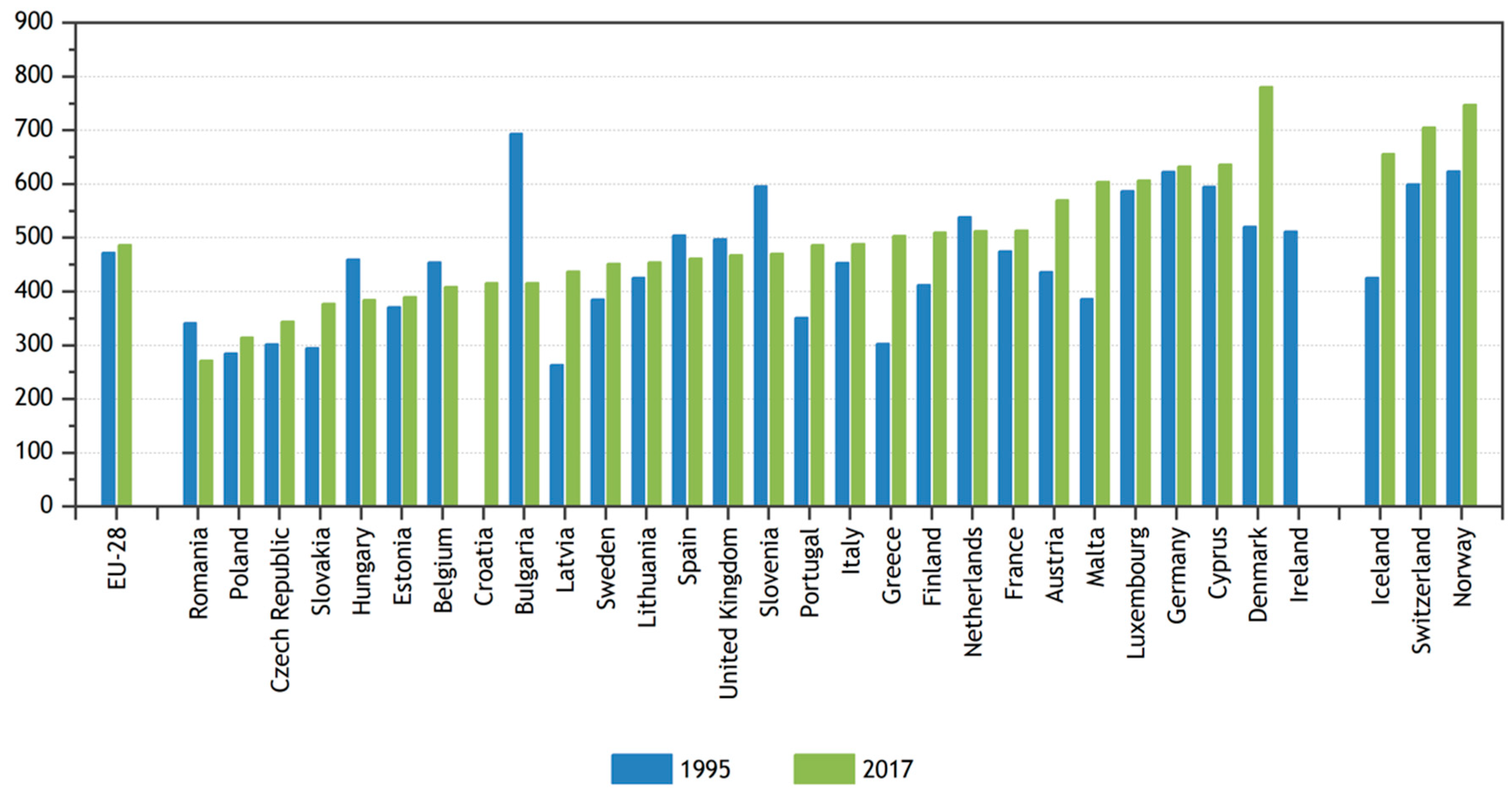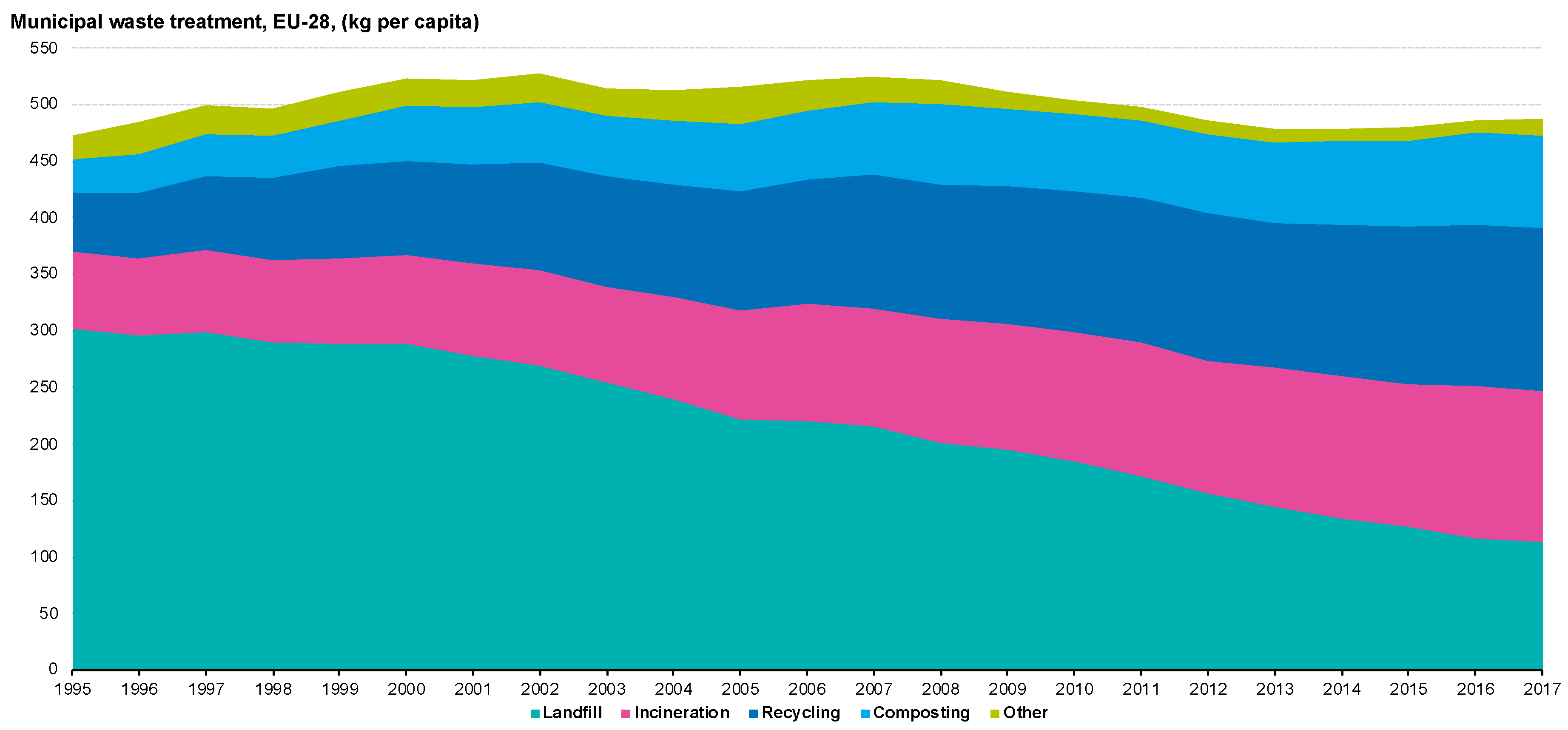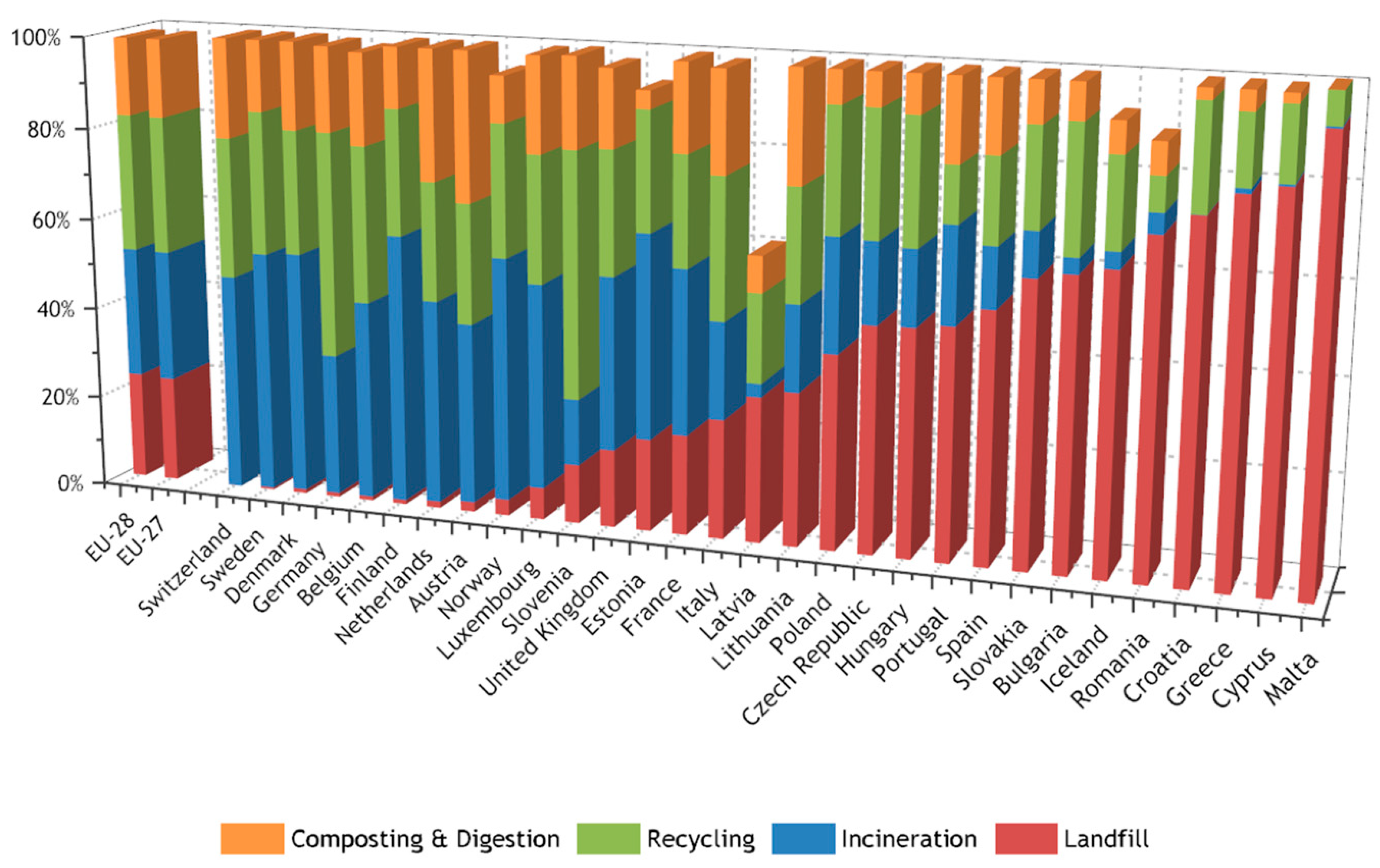Municipal Solid Waste (MSW) management has been a major problem of modern cities for many years. Thus, the development of optimal waste management strategies has been a priority for the European Commission, especially in the transition toward a circular economy. Efficient waste streams sorting is of vital importance for the effective implementation of an integrated waste management system toward the sustainable management of MSW.
Municipal Solid Waste (MSW) management has been a major problem of modern cities for many years. Thus, the development of optimal waste management strategies has been a priority for the European Commission, especially in the transition toward a circular economy. In this paper, an analysis of different MSW treatment methods that can be effectively implemented in the Region of Central Macedonia (RCM) is provided, and their comparison from an environmental point of view is performed. The assessment is based on real data indicated in the recently updated Greek National Waste Management Plan, whereas the different scenarios developed include landfilling without energy recovery, landfilling with energy recovery, recycling and secondary materials recovery, mechanical-biological treatment, bio-waste composting and anaerobic digestion with energy recovery, and incineration with energy recovery. The obtained results illustrate that efficient waste streams sorting is of vital importance for the effective implementation of an integrated waste management system toward the sustainable management of MSW.
- Environmental Impact Assessment
- Integrated waste management plan
- Sustainable waste management practices
- Municipal Solid Waste (MSW)
- Life cycle Assessment (LCA)
- Sustainability Assessment
1. Introduction
Dear author, the following contents are excerpts from your papers. They are editable.
(Due to the lack of relevant professional knowledge, our editors cannot complete a complete entry by summarizing your paper, so if you are interested in this work. you may need to write some contents by yourself. A good entry will better present your ideas, research and results to other scholars. Readers will also be able to access your paper directly through entries.)
1. Introduction
Waste management can be characterized as the strongest common threat that all countries are facing worldwide. Regardless of its content/composition, directly or not, waste is one of the greatest challenges of the urban world [1]. Although until recently urban solid waste was not considered to be a problem, nowadays more and more countries around the world develop waste management strategies, studies, and projects [2].
The world population is constantly growing, while lifestyles and trends are changing rapidly. As such, the increasing quantities of municipal waste is a key issue in modern cities worldwide, and one of the major challenges for municipalities is the collection, recycling, treatment, and disposal of solid waste [3]. It should be highlighted that in the European Union (EU), the “Waste Framework” Directive [4] and the “Landfill Directive” [5] are setting the regulatory framework within which member states should adopt more environmentally friendly options, based on the “Waste Hierarchy” concept [4][6], which prioritizes the waste management concepts of reduce, reuse, recycling/compost, and energy recovery from waste, thereby aiming at waste prevention and landfill minimization [4][6]. As a result, over the last two decades, the political emphasis on municipal waste is very high in all European countries, despite the fact that municipal waste represents only 10% of the total waste generated in the EU [7]. The different waste policies set various targets at the EU level concerning the management of certain types of waste. For instance, in 2015, the European Commission recommended new objectives for municipal waste of 60% recycling and preparing for reuse by 2025 and 65% by 2030 [8].
The world population is constantly growing, while lifestyles and trends are changing rapidly. As such, the increasing quantities of municipal waste is a key issue in modern cities worldwide, and one of the major challenges for municipalities is the collection, recycling, treatment, and disposal of solid waste [3]. It should be highlighted that in the European Union (EU), the “Waste Framework” Directive [4] and the “Landfill Directive” [5] are setting the regulatory framework within which member states should adopt more environmentally friendly options, based on the “Waste Hierarchy” concept [4,6], which prioritizes the waste management concepts of reduce, reuse, recycling/compost, and energy recovery from waste, thereby aiming at waste prevention and landfill minimization [4,6]. As a result, over the last two decades, the political emphasis on municipal waste is very high in all European countries, despite the fact that municipal waste represents only 10% of the total waste generated in the EU [7]. The different waste policies set various targets at the EU level concerning the management of certain types of waste. For instance, in 2015, the European Commission recommended new objectives for municipal waste of 60% recycling and preparing for reuse by 2025 and 65% by 2030 [8].
2. Waste Management Options in Europe
Waste generation as well as waste management options are different for each European country, and are dependent on various factors, such as: (i) economic growth, (ii) population density, (iii) consumer behavior, or (iv) existing waste management facilities [4]. Data on municipal waste have been collected by Eurostat since 1995 and are widely used for comparing and getting information about municipal waste generation and treatment across EU countries. According to these data, the total municipal waste generation in EU countries declined approximately 5.4% from 2005 to 2017. However,
illustrates that in 21 of the 31 countries (Member States and EFTA), the volume of municipal waste generated per capita increased from 1995 to 2017. Based on 1995 and 2017 data, the highest average annual growth rates were recorded for Greece and Latvia (both 2.3%), as well as Malta (2.0%) and Denmark (1.9%). On the other hand, Bulgaria has the largest reduction, with an annual average decrease of −2.3%, followed by Slovenia (−1.1%) and Romania (−1.0%) [9].
Figure 1.
Municipal waste generated by country in 2005 and 2017, sorted by 2017 level (kg per capita) [9].
With respect to the management of municipal waste and specific treatment strategies,
presents the total amount of waste generated in the European Union (EU-27) for the period from 1995 to 2017 and the amount of waste by treatment category. More specifically, during the last 20 years, the total municipal waste landfilled in the EU-28 decreased by 60 %, from 145 million tons in 1995 to 58 million tons in 2017. In the period between 2005 and 2017, landfilling has diminished by as much as 5.3 % per year on average, and thus the landfilling rate compared with municipal waste generation dropped from 64% in 1995 to 23% in 2017. Besides that, the amount of waste recycled increased from 25 million tons in 1995 to 74 million tons in 2017 at an average annual rate of 5.1%, and the recovery of organic material by composting has also risen, with an average annual rate of 5.2% for the same period. Waste incineration has also increased. Since 1995, the amount of municipal waste incinerated in the EU-28 has risen by 34 million tons and accounted for 68 million tons in 2017. Nevertheless, mechanical biological treatment (MBT) and the sorting of waste are not covered directly as categories in the relative reporting of municipal waste treatment [9].
Figure 2.
Municipal waste treatment by type of treatment, EU-28, (kg per capita), 1995–2017 [9].
It should be noticed that the overall waste management systems differ significantly among EU countries. More specifically,
depicts the volume of municipal waste landfilled, incinerated, recycled, and composted in 2016 as a percentage of the total waste treated. Some countries have significantly reduced their landfill rates (sometimes below 5%) by adopting sophisticated and modern waste management schemes, taking into consideration the most preferable principles that the “Waste Hierarchy” concept promotes. Indicatively, it should be noted that Switzerland, Germany, and Sweden demonstrate a near to zero (0%) percentage of landfill rate, whereas the same rate for Belgium, Denmark, Netherland, Austria, Finland, and Norway is below 5%. In contrast, for the majority of the EU countries, landfilling is the basic treatment method for more than 50% of the total municipal waste treated. Last but not least, it should be underlined that Malta and Greece have the highest landfill rates in the EU, with 92% and 82% of the total waste production, to be disposed of in landfills, respectively, while Latvia, Croatia, and Cyprus also predominantly employ the same bad waste management performance regarding the landfill of waste (i.e., landfill rate above 70%) [9].
Figure 3.
Municipal waste treated in 2016 by country and treatment category, sorted by percentage of landfilling (% of municipal waste treated) [9].
Consequently, there has been a growing interest in the sustainable management of Municipal Solid Waste (MSW), which covers: (i) generation, (ii) collection, (iii) transfer, (iv) sorting, (v) treatment, (vi) recovery, and (vii) disposal of waste. On the above basis, significant research has been performed on integrated MSW management systems, which include various options like materials recycling, biological treatment of biodegradable fractions, composting, or thermal treatments with energy recovery. The literature review on MSW management revealed a variety of examples on the approaches used by EU countries. Several publications have appeared evaluating various MSW management strategies at the local, regional, and national level. Different practices on waste management have been reviewed for countries such as Germany, Denmark, Greece and other European countries [10][11]; for regions: Lombardia, Italy [12]; and for cities: (i) Niš, Serbia [13], (ii) Porto, Portugal [14], (iii) Naples, Italy [15].
Consequently, there has been a growing interest in the sustainable management of Municipal Solid Waste (MSW), which covers: (i) generation, (ii) collection, (iii) transfer, (iv) sorting, (v) treatment, (vi) recovery, and (vii) disposal of waste. On the above basis, significant research has been performed on integrated MSW management systems, which include various options like materials recycling, biological treatment of biodegradable fractions, composting, or thermal treatments with energy recovery. The literature review on MSW management revealed a variety of examples on the approaches used by EU countries. Several publications have appeared evaluating various MSW management strategies at the local, regional, and national level. Different practices on waste management have been reviewed for countries such as Germany, Denmark, Greece and other European countries [10,11]; for regions: Lombardia, Italy [12]; and for cities: (i) Niš, Serbia [13], (ii) Porto, Portugal [14], (iii) Naples, Italy [15].
Within this context, Life Cycle Assessment (LCA) methodologies and tools are increasingly used in MSW management, as they offer a very efficient and useful tool which effectively supports the decision-making of a waste management policy by evaluating and comparing the environmental impacts of the various waste management systems, schemes, and practices. It should be underlined that LCA is an assessment method, which can be applied to determine the entire environmental impact of a product or system over its entire life. Since 1995, LCA has been used for the evaluation of waste management practices, and the implementation of the ISO 14044 standards for LCA methodology globally, as well as the introduction of the EU Waste Framework Directive [4], led to an increase of LCA applications in MSW management sector after 2008 [16]. Moreover, previous research on the evaluation methods used on waste management sector had demonstrated that around 40% of reviewed articles are LCA-based [13]. Thus, in recent years, the utilization of LCA methodologies and tools has become very popular, as several publications have been introduced, documenting LCA use for the evaluation of various scenarios of MSW management practices in a wide range of countries across Europe. Indicatively, there are various publications that include Serbia [13], Spain [17][18][19], Portugal [14], Italy [3][15][20], UK [21][22], Norway [23], Sweden [24], Denmark [10][25].
Within this context, Life Cycle Assessment (LCA) methodologies and tools are increasingly used in MSW management, as they offer a very efficient and useful tool which effectively supports the decision-making of a waste management policy by evaluating and comparing the environmental impacts of the various waste management systems, schemes, and practices. It should be underlined that LCA is an assessment method, which can be applied to determine the entire environmental impact of a product or system over its entire life. Since 1995, LCA has been used for the evaluation of waste management practices, and the implementation of the ISO 14044 standards for LCA methodology globally, as well as the introduction of the EU Waste Framework Directive [4], led to an increase of LCA applications in MSW management sector after 2008 [16]. Moreover, previous research on the evaluation methods used on waste management sector had demonstrated that around 40% of reviewed articles are LCA-based [13]. Thus, in recent years, the utilization of LCA methodologies and tools has become very popular, as several publications have been introduced, documenting LCA use for the evaluation of various scenarios of MSW management practices in a wide range of countries across Europe. Indicatively, there are various publications that include Serbia [13], Spain [17,18,19], Portugal [14], Italy [3,15,20], UK [21,22], Norway [23], Sweden [24], Denmark [10,25].



